Living in Zumbrota
Zumbrota, located in southeastern Minnesota, is a charming city with a population of around 3,300 people. Nestled along the Zumbro River, the town is known for its picturesque landscapes and a rich history dating back to the mid-19th century. Zumbrota boasts well-preserved historic buildings, including the covered bridge, attracting visitors interested in its cultural heritage. The community embraces a small-town atmosphere with friendly locals, community events, and a focus on outdoor recreation. The city hosts the Covered Bridge Music & Arts Festival annually, showcasing local talent. Zumbrota is also home to the Crossings at Carnegie, an arts and cultural center that contributes to the town’s vibrant artistic scene. With its blend of history, natural beauty, and cultural offerings, Zumbrota provides a tranquil and welcoming experience for residents and visitors alike.
1. Cost of Living
Zumbrota, Minnesota, generally offers a cost of living that aligns with the national average. Housing costs are moderate, with a mix of affordable housing options, including single-family homes and apartments. Utilities, transportation, and grocery expenses are typically in line with the national average as well.

While healthcare costs may vary, the presence of medical facilities in nearby towns ensures access to essential services. Zumbrota’s cost of living may appeal to those seeking a balance between affordability and a comfortable lifestyle. However, it’s essential to consider individual preferences and lifestyle choices when assessing the cost of living, as personal spending habits and priorities can influence the overall affordability of residing in this charming Minnesota town.
2. Safety
Zumbrota, Minnesota, generally maintains a reputation for being a safe and peaceful community. As with any town, crime rates may vary, but Zumbrota tends to experience lower crime levels compared to national averages. The town’s close-knit community and small population contribute to a sense of security, where residents often know each other. Zumbrota’s commitment to community engagement and local law enforcement efforts plays a role in maintaining a safe environment.

While no place is entirely devoid of crime, Zumbrota’s emphasis on public safety contributes to its overall positive reputation as a safe and welcoming community for residents and visitors. It’s always advisable to stay informed about local safety measures and be aware of one’s surroundings, but Zumbrota generally offers a tranquil and secure living environment.
3. Schools
Zumbrota, Minnesota, is served by the Zumbrota-Mazeppa School District, which is dedicated to providing quality education to students in the area. The school district is known for its commitment to academic excellence, and the schools in Zumbrota generally receive positive reviews.

Zumbrota-Mazeppa Public Schools offer a range of educational programs, extracurricular activities, and support services to meet the diverse needs of students. Small class sizes often allow for more individualized attention, fostering a positive learning environment. The community’s involvement in education is evident through parental engagement and support for school activities.
While specific opinions about schools can vary, Zumbrota is generally recognized for its strong emphasis on education, dedicated teaching staff, and the overall positive learning atmosphere. Families considering a move to Zumbrota can explore the local schools and resources to ensure they align with their educational preferences and values.
4. Job Opportunities
Zumbrota, Minnesota, is a relatively small town, and job opportunities may be more limited compared to larger urban areas. The local economy often revolves around industries such as agriculture, healthcare, education, and small businesses. Job opportunities may be available in sectors like manufacturing, retail, services, and public administration.

Residents of Zumbrota may also commute to nearby towns or cities for additional job prospects. The broader region’s economic landscape, including the nearby Rochester metropolitan area, may offer more diverse employment options.
As with any location, the availability of jobs can vary, and it’s advisable for individuals seeking employment in Zumbrota to explore job listings, connect with local businesses, and consider the overall economic conditions of the region. The job market in smaller towns often relies on a mix of local businesses, community services, and nearby economic centers.
5. Weather
Zumbrota, Minnesota experiences a typical Midwestern climate with distinct seasons. Winters are cold and snowy, with average temperatures ranging from 10°F to 25°F (-12°C to -4°C). Residents can expect snowfall and chilly conditions from November to March.

Spring brings a gradual thaw, with temperatures rising from 30°F to 60°F (-1°C to 16°C) between March and May. Summers are warm, with average highs of 70°F to 80°F (21°C to 27°C) from June to August, offering pleasant weather for outdoor activities. Fall is characterized by cooler temperatures, vibrant foliage, and average highs decreasing from 60°F to 30°F (16°C to -1°C) between September and November. Overall, Zumbrota’s climate reflects the diverse weather patterns of the Midwest, providing residents with a mix of seasonal changes throughout the year.
6. Transportation
Zumbrota, Minnesota, has a typical small-town transportation infrastructure. Residents primarily rely on personal vehicles for daily commuting, as public transportation options are limited. The town is accessible by major highways, including U.S. Route 52, facilitating travel to nearby areas.

For those who prefer public transportation or air travel, larger cities like Rochester, approximately 20 miles south of Zumbrota, offer more extensive options. The Rochester International Airport provides regional air travel connections.
Bicycling and walking are feasible within the town, given its size and community-oriented layout. However, due to the rural nature of the area, these modes of transportation might be less practical for longer distances.
In summary, Zumbrota’s transportation landscape centers around personal vehicles, with broader options available in nearby urban centers for those seeking additional travel alternatives.
7. Culture and Community
Zumbrota, Minnesota, fosters a close-knit community with a rich cultural heritage. The town values its history, evident in the well-preserved architecture and landmarks like the iconic covered bridge. Community engagement is a hallmark, with residents actively participating in events like the Covered Bridge Music & Arts Festival and supporting local initiatives.

The cultural scene is enriched by institutions like the Crossings at Carnegie, an arts and cultural center hosting various events, classes, and exhibits. Zumbrota’s community spirit is reflected in its friendly and welcoming atmosphere, where neighbors often know each other.
The town embraces outdoor activities, benefitting from its scenic location along the Zumbro River. Residents enjoy a laid-back lifestyle, and the community’s commitment to education and shared values contributes to a strong sense of unity. Overall, Zumbrota’s culture is characterized by a blend of historical appreciation, community involvement, and a connection to the natural surroundings.
8. Healthcare
Zumbrota, Minnesota, benefits from access to healthcare services, ensuring residents have essential medical support. While Zumbrota itself may have limited healthcare facilities, nearby towns and cities, such as Rochester, provide comprehensive medical services. Rochester, home to the renowned Mayo Clinic, offers world-class healthcare facilities and specialists.

Residents of Zumbrota can access local clinics, general practitioners, and emergency services for routine and immediate healthcare needs. Additionally, the proximity to larger medical centers enhances the availability of specialized care.
The healthcare system in the area contributes to the overall well-being of Zumbrota’s residents, providing a range of medical services and expertise. As with any community, individuals may find comfort in the presence of healthcare facilities in nearby areas for both routine medical care and more specialized treatments.
Categories




